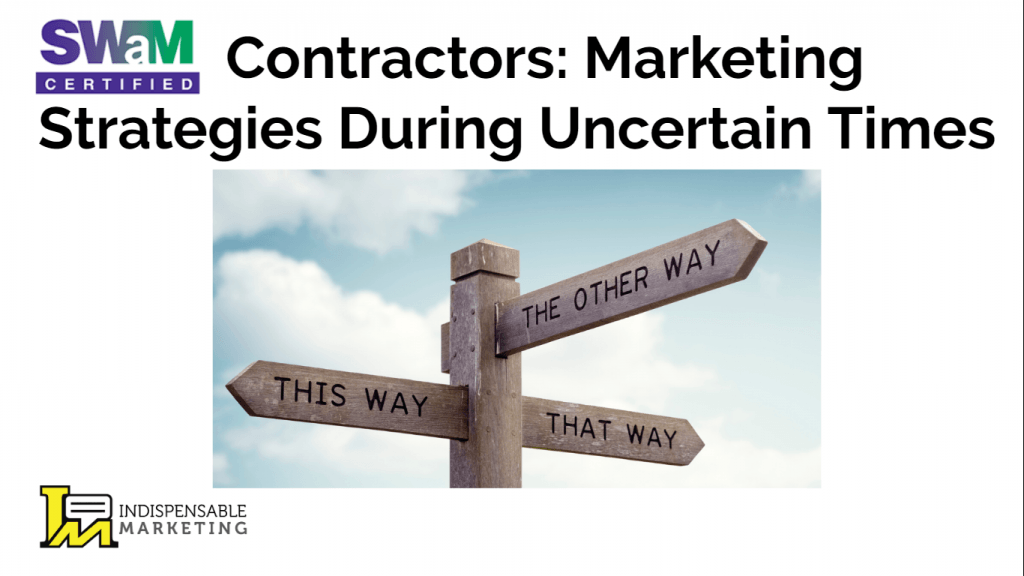Government Marketing Strategies for a SWaM Business
Today’s topic is Government Marketing Strategies During Uncertain Times for SWaM (Small, Women- and Minority-owned Businesses), one of my favorite groups of businesses to speak with. While some of this information is focused on doing business with VCU (Virginia Commonwealth University), the senior buyers and supplier diversity specialists from other government agencies who attended felt it was applicable to them as well. Below is the transcript from the presentation.

I’m Patrick McFadden, owner and founder of a small business marketing consulting firm called Indispensable Marketing. I’m excited today because I’m going to be talking about marketing strategies during uncertain times.
What’s great about this is that some of the things I’m going to talk about may or may not correlate or directly relate to your marketing, but I promise you it is essential to keeping the promise that we make to our clients, which is to help government contractors present their business as capable, professional, and successful at doing the work they’re trying to win , and that’s what I’m going to be talking about. What can you do to position your business in a way so you can win the work that you’re going after?
Now, government contractors always ask, “what do we mean by goNow, government contractors always ask, “What do we mean by government marketing and in what ways can we support them?” For us at Indispensable Marketing, it’s these specific marketing elements.
- We help create targeted messages and documents to specific agencies, primes, decision-makers and opportunities.
- We help our government clients build what we call “the obvious choice online presence” that mitigates perceived risk, builds trust, and supports your business development efforts.
- We work on developing differentiators that impress a range of decision-makers you need to get in front of.
- We also make sure that your website is effective, which means that it offers the specific information that decision-makers want to see.
- We then take a systematic approach to everything that we do. There’s a process, a plan, and a way to get it done.
- Finally, we focus on ways that marketing supports the individual efforts of your business development or capture person.
Those are the specific ways that we help government contractors present their business as capable, professional, and successful at doing the work they’re trying to win.
The government marketing strategies I’m going to cover over the next hour are strategies you need to be able to see, learn, and explore. Like I said, some of the things may not relate to your marketing, but I promise to present your business as capable, professional, and successful, as it does relate to marketing.
#1: Know The Environment – Fully grasp what’s going on
So, I want to start off with the first marketing strategy for uncertain times: know the environment. This is something that’s tough for SWaM businesses because you are operating with limited time, limited resources, and limited attention spans, and this marketing strategy requires all of those things. However, if you’re going to be operating in the VCU procurement environment or any government procurement environment, you have to fully grasp what’s going on.
So, I want to talk a little bit about the economics. You have to understand what generates revenue for the agency or the entity you want to do business with. If you’re looking to do business, not only just with VCU, but any state university, the economics is revenue. Revenue comes from student enrollment, so you have to understand which solutions in your product or service offering align back to the economics of the school, especially in environments where things are uncertain.
Another key aspect that SWaM businesses need to be aware of is the tier of the school you’re pursing. Some of you may not know this, but VCU is called a tier three school, which means they can offer different procurement options and contract vehicles than other universities. This is important is because, as a SWaM or small business, you have to be narrowly focused on the contracts, relationships, and agencies that you do business with.
By knowing that you may work well with tier two, three, or four schools, you’re able to pinpoint the contract opportunities and agencies that you want to build relationships with and do business with, and if you know that tier three schools are best for SWaM businesses, then you may want to focus your efforts on tier three universities.
Next, know the current needs, missions, and objectives of the government agency you’re trying to do business with or currently doing business with, and, once you learn them, use that insight to connect your solutions to address them. Obviously, we know universities at this current time are looking for PPE.
They have a mission, a mandate, and a need to keep students safe and to also make sure students feel confident enough to enroll. Knowing that those are some of the issues, does your solution address them? If it does, you need to tie that together with messaging, documents, and education to let procurement professionals or supplier diversity specialists know that’s the case.
Next, understand procurement methods. So, VCU has created programs to help SWaM businesses. One of the examples is a SWaM spot award, which is a (single non-recurring) purchase ≤ $100,000. This is important because, if you don’t know that this procurement vehicle exists and don’t understand the details of this spot award, a senior buyer could come to you and say, “Hey, I want to give you a SWaM spot award based on this opportunity because your business can fill this need. Give me a quote,” and you would quote in return, “It’s going to cost $110,000.”
Well, this particular procurement method only goes up to a $100,000. So, by not knowing and understanding the details of that, you’ve priced yourself out of the opportunity. Make sure you familiarize yourself with the procurement methods and you understand what opportunities exist for SWaM businesses.
Next, to understand what’s going on, read Do Business with VCU. I put the link in here so just in case someone wants a copy of this presentation, but you can go to that website and read about doing business with VCU. There are step by step forms, processes, information, and other things that you’ll want and need to know.
Be familiar with the general terms and conditions. These are some of the things that the best in class SWaM businesses are doing, and they help protect you, not only in uncertain times, but in great times, because like I said, the more you understand about the environment, the more you can speed up the process of doing business with you.
Next some of you may not have thought about or even considered this but offer prompt payment discounts. Make it an incentive for getting paid faster. That’s a great idea and it works. So, in uncertain environments, always fully grasp what’s going on and take the time to know the university, know the needs, understand the environment, know the ways you can get paid, know how they like to procure, and understand the terms and conditions.
#2: Effective and Frequent Communication – Responsiveness and the right information matters
Marketing strategy #2 during uncertain times is something most businesses do not consider as a marketing strategy: effective and frequent communication, but it is, because at the end of the day, communication is the key factor in determining:
- whether a customer is retained,
- whether the customer spends more time with you, and
- whether you outsell the competition.
Now, responsiveness and the right information is part of effective communication. I don’t think a lot of SWaM contractors even consider this but keep your contact information updated.
I can’t tell you how many times I’ve heard from senior buyers and supplier diversity specialists that they have a $100,000, $300,000, or $700,000 contract to award a SWaM business, and the issue is that they can’t get in contact with the contractor. They said, “Instructions said to email this specific key contact or always call this key person, but that individual is no longer employed at the company and probably has been gone for 3 months, so now opportunities are being missed,” then they’ll get a call, weeks or even months later in some cases, saying, “Is that opportunity still available?” Of course it’s not, so keeping your contact information updated is critical for effective communication.
Educate on your approach to solving problems. So, in times like this, I think it’s key to focus on: have you been able to eliminate a step or two in the process of getting an end result for an agency? Have you been able to incorporate technology that allows you to serve a government agency or prime faster and more efficiently? If so, you need to educate those decision makers, supplier diversity specialists, and senior buyers. You have to make everyone that you come into contact with your advocate, and you do that by educating them that “We have evolved our approach to solving your problem, and I would love to discuss that with you, show you how this saves cost on your end, ties back to your bottom line, and puts it all together.” So, educate on your approach to solving problems.
If you have furloughs (and it happens), you have to inform the procurement point of contact about that so the options can be discussed. Perhaps, instead of getting that work done in two weeks, it could be stretched to three weeks to allow your staff to complete it, but if you have furloughs and you’re not communicating, you’re leaving your key point of contact and maybe advocate to guess, and nobody wants to be left guessing instead of knowing. So just make sure (if that happens)to mention it so options can be discussed around the delivery of the service and contract obligations.
Now, one of the things that the best in class SWaM contractors are implementing at this moment is offering communication options. They’re scheduling times of availability for them to speak with senior buyers, supply diversity specialists, or the end-users; instead of offering the office phone number, they’re offering their direct phone number. Another communication option that they’re implementing is setting the appointment on their calendar to say, “This is my appointment for today or next week,” and also having scheduled times of availability such as 10am-1pm. With senior buyers and supplier diversity specialists working at home right now, they’re able to offer this type of communication flexibility, and they’re open to that. So, make sure that you can incorporate that somehow, in some way.
Most terms and agreements have your response time in there, but here’s my recommendation: 24 hours is good. 2 hours is better. 2 minutes is best. If you can respond back within that time frame, that’s going to be the best chance for a SWaM firm to acquire, retain and keep contracts.
The last part about effective communication is when you’re working with any vendor, but especially VCU, make sure you have a valid purchase order, a signed contract, or you’ve been presented with a P-card before you start working and start delivering your service. That’s so important, especially as a SWaM business. You don’t want to work and not get paid, so just make sure that you have good communication habits.
#3: Innovate and Educate – The reality of SWaMs
Alright; we’re going to move into the third marketing strategy during uncertain times, which is about innovation and education. Now, this is just the reality of being a SWaM or small women and minority owned business, and it’s just a fact that you’re going to have capacity limits.
That’s just the way it works until you can get enough human capital or figure out how to infuse technology to streamline some things. You’re going to have capacity issues, so what I want to talk to you about is how to build strategic relationships to overcome that. As a SWaM business, you have to be prepared and start looking to build relationships that increase your capacity levels. Some people call it augmented staffing, but you have to figure out if there is a way you can either partner with the company or bring in a company only when you need them to help with a specific aspect of a contract.
Look for ways to streamline your service delivery or the end result. Are there ways that you could have relationships that allow you to deliver the service faster and better?
Be prepared to evolve your business offering. I want you to think about which relationships could allow end to end servicing.
As a quick example, let’s say that you’re in the business of delivering equipment, but the contract needs you to install that equipment. Well, in your business, you should already have a strategic relationship that can fulfill that component, so you need to be building relationships with other businesses to say “Hey, if I have an opportunity that comes in, we need to be able to talk it out and have procedures or guidelines of working together where you can come in; you don’t have to worry about the delivery and the logistics of this equipment, I just need your installation service,” so it’s easier to price it out and get that in, but that’s going to allow a senior buyer or a supplier diversity specialist to bring you into that contract and say “Okay, I know that they have a system for not only being able to deliver the equipment, but perform end to end servicing, which can be installation.”
This is no different from other industries. You have companies who plan and companies who implement the plan. You have companies who design and companies who build the design. You have companies who deliver and companies who install the elements delivered. So, think about, in your business, what does that end-to-end servicing look like? What relationships do you need to build, just in case that needs to be part of the contract? These capabilities need to be present at a moment’s notice, giving you the ability to come in and actually deliver on every aspect of a contract.
Finally, take contracts and opportunities that you can 100% deliver on if nothing else. Here’s why: I’m calling them reputation deposits. You have to make deposits before you make withdrawals. If you take an opportunity that you’re not 100% sure you can deliver on, you’re hurting your reputation, and that means you’re making a withdrawal before you even made a deposit, which puts you in the negative and limits your chances of getting another opportunity.
I really want to challenge you to look at what relationships would allow you to increase your capacity and will allow you to deliver the end-to-end type of servicing or streamline your service delivery, and as a SWaM business, it’s okay to partner. It’s okay to share that piece of cake.
#4: Develop a Obvious-Choice Online Presence – No online presence, no opportunities
This next marketing strategy during uncertain times is based around developing an obvious-choice online presence. I think we’re at the point where every business person knows you need a website. We’re past that today, and we’re at the point where it’s about an online presence that makes you the obvious choice, because, whether you believe it or not, you’re making that impact whether you have a presence online or not, because most of the research that procurement professionals are doing today is online, and when a senior buyer or someone who’s advocating for you is thinking about your business, they may need a leg to stand on. They may need to say, “Hey John, check out this company here,” and the only tool they have is the content you’ve made available online, so we’re also past the point of just having a website built. You need to know how to communicate through your online presence that your firm is the obvious choice, and that doing business with you is going to be a success and not a risk.
So, a lot of government contractors just want to build a website. It’s not just having it built, it’s having the right information on there as well. I promise you, I’ve talked to a lot of professionals in the state and local procurement space, and I will tell you, if you have a limited or no online presence, you’re limiting your opportunities. This is the truth, and in some cases, no online presence means no opportunities and you’ll be looking for a job. I’m going to tell you how to do that. There would be no need for me to tell you about it and not give you all of the information.
So here are the online presence must haves:
- You must have an effective website, one that builds trust, one that demonstrates your expertise, one that allows end-users and procurement professionals to say, “I can see us doing business with you; you speak our language.”
- SEO. You have to at least be found for your own name. That’s rule number one. If I type in your name into Google, you have to show up.
- You need downloadable materials, whether that’s a capability statement or a briefing sheet, something that somebody could use that acts as a salesperson for you. Good news too: if you build your online presence properly, that is your additional salesperson 24/7. You could be sleeping at 1:00 AM and a procurement professional, senior buyer or supplier diversity specialist could be looking at your website or a component of your online presence.
- Up to date and active Eva account. That’s online. That’s part of your online presence. It represents your company, and part of that is having the right commodity codes within that Eva account. That’s so important.
- An active SWaM status is part of having a good online presence, an obvious-choice online presence, and an up-to-date SBSD directory listing.
These are what I’m going to call, for a SWaM business, the essentials for an online presence. You must have these things in order.
Now, your website is a separate deal, so I’m going to call this the website essentials for SWaM contractors .
- On your website, please have a government contracting page, or please have a page dedicated to contracting. Whether that’s state, local, or very targeted towards a university, you need to have a page speaking to the exact audience you want to talk to.
- You need to incorporate trust and credibility elements. That could be past performance, or it could be your certifications. You want to incorporate those things that build trust and build credibility. It could be a video or a demo of your service or product. It could be a process chart of how you go about doing what you do.
- Have the right contact information. I think we talked about how important that is.
- Keywords and code information needs to be on there, and, in some cases, you may even have your contract vehicles.
- Core services. People come to look for one thing and they found out you do another, so you don’t want to limit your opportunities. You want to say, “Here are the things and the problems that our services solve,” and that moves me to my next one.
- For some of you, instead of listing your services, you may just say “We need to offer solutions by need.” So, if the need is X, Y, and Z, then we have solutions for those needs because of the number of services that you may offer.
- You need a downloadable capability statement.
These are the essentials for a SWaM contractor.
At this point, I hope this has enlightened you, made you aware, and made you say “Yes, I see what’s possible. I see what can happen,” because the truth is that many of us who own our own businesses can think about a decision or two that you can make today that would negatively impact your revenue over the next week or two. I’m sure most of us would go, “Yep, there’s a decision or action I could take that would negatively impact my revenue.” Well, I’m going to challenge you to think the opposite way. Is there something that you could do today or this week that could positively affect your revenue? Of course, the answer is yes. I’ve heard of cases where, like I said, people have missed out on a half million, a hundred thousand, or a $50,000 contract because they don’t have the right information.
So, we’re here to solve that problem and help government contractors present your business as capable, professional, and successful at doing the work they are trying to win . If you would like us to look at your website, we’d be happy to do that, provide you with three recommendations on how to present your business as those three elements.




